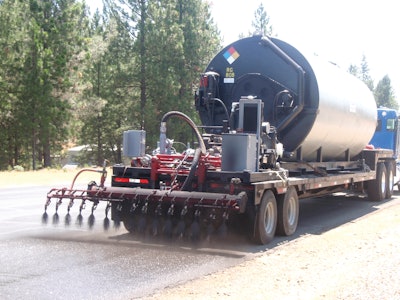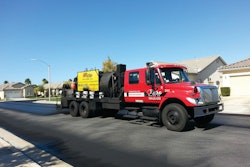
One warm afternoon a few years back I received a call from a customer who was experiencing difficulty with a new machine. He was having fits trying to spray an asphalt-based, high-aggregate loaded emulsion. The machine he was using was recently calibrated at the Rayner Equipment Systems office in California using the SteelGuard brand of material and had worked perfectly. We asked all the expected questions including the thickness of their material. We were told “the material was not too thick” and all our testing proved the machine was working correctly yet he was still unable to spray effectively. After our attempts of phone troubleshooting failed to identify the problem, we determined a site visit was needed to understand this issue.
After a multi-leg plane flight involving some of my favorite airports, we arrived and started to triage the machine. Starting with the reverse path the material takes getting to the spray tips, our findings surprised us. Opening the spray bar we were confronted with seal material that was the consistency of chunky peanut butter. I asked the customer what happened to the material that was in the machine when we were talking on the phone and was told “this is the material”! It was obvious that we were talking different languages because what we think is thick material was obviously not what the customer thought was thick material. We were able to resolve the issue by addressing the three key elements required to spray any product.
- Viscosity of the material. Can we lower the viscosity of the customer’s material staying within the manufacturer’s limits? The manufacturer of the material has a maximum percentage of water that is allowed before material damage occurs. Adding water to the concentrated material will lower the viscosity; lower viscous materials are easier to spray!
- Force applied to the liquid. Can we increase the pressure on the material to FORCE the material through the spray tips? The higher pressure will cause increased wear on the material pump, increased wear on the internal parts of the spray tips and the higher atomization of the material as it passes through the spray tip. Increased pressure can also cause high heat which can adversely affect some sealcoat systems.
- Size of the spray orifice. Can we install larger spray tips that will accommodate thicker material? The size of the orifice or spray tip has a huge impact on the process and the finished surface. The tip size can be increased to the point where the material is dumping out in a solid stream. This is obviously not going to leave the desired, attractive finish.
Remember that changing any one of the three can improve or hamper a machines ability to spray.
Our customer wanted to spray this material maintaining the thickest consistency possible. (Least amount of water in the mix so they could have it dry faster.) The final result was a little of all three. We added a higher percentage of water, changed the spray tips from 80/70 to 80/100 and increased the pump pressure from 35 to 45 psi. Spray tips are sized in two areas. The first number is the degree of fan. In both tips referenced here the fan is an 80 degree. The second is the volume, a 70 is 7 gallons of water under 40 psi pushing force. The 100 is 10 gpm. We were able to spray apply the material in the manner that was advantageous to the customers’ requirements. Because we took the time to understand both the process and the final goal we were able to find a solution that met both.
An important lesson learned was that this could have been resolved much faster and at a much lower cost to both the contractor and the equipment manufacturer. We determined that the word “thick” was too subjective and the root of this problem!
Question: How do you change the subjective nature of a definition situation?
Answer: Create a measurement that can be universally employed with common results.
Since one of the three critical factors to spraying material is Viscosity or Thickness, we set out to find a tool/method that would allow an operator in Bangkok, Bristol or Boston to have the same measurement to answer “How thick is your material?”
How do we speak a common language that will remove the subjective element? We called upon a tool used in the paint industry for many years that helps a painter know when the paint is thin enough to spray. A Zahn Cup was modified to match the orifice sizes we use in our industry, and then we created a matrix that provides for easy calibration.
The Zahn cup works off of a very simple concept. The volume of the cup has a calibrated capacity and the orifice is also of a specific size. (In our application we increase the size of the orifice to match the orifice size of the specific spray tip.) This will help us understand our material. Start with a concentrated material and test how long it takes to drain the cup. Do this test three times for each percent of cut and record the data on a chart. Repeat this process by adding 1% of water, test three times then add the next 1%. Take this all the way to the max amount your supplier will allow in the material. Below is a chart that shows how each % equals less time in the cup. The only time you will need to repeat this process is when your material changes.
This new tool opened our eyes to other very valuable functions.
- Checking for consistency of new concentrated material BEFORE it is applied.
- Checking that our material has the correct water percentage.
- Knowing how much water to add when topping off an existing load.
- Proving to our customers that we know exactly what we are applying and being able to demonstrate our knowledge!
It is common practice for a company to start with a load of seal in a concentrated form and add the prescribed volume of water. This is a simple process and it is usually easy to calculate the exact amount of water needed. The accuracy of how that water is added can sometimes be questionable. This tank of material is now hauled to a job where a partial volume is used then returns to “top off” the tank for the next project. Now the tank is refilled with more concentrated material requiring a new introduction of water. How much water should be added? Is it likely that a crew will add the correct amount of water or is a rough guess more likely?
The dip stick is a common method for measuring tank volume. Dip the tank and calculate how much you have left then calculate how much to add of concentrate and water. Using this method you have to assume the volume in the tank has the correct percent cut. Was the last load from a hot afternoon where more water was needed or a cold morning where less water was added? The experienced guess is the most common method employed today.
We strongly encourage you to find a measurement device that is inexpensive and easy to use. The results can be powerful. The benefits to you as the applicator are easy to recognize but consider the benefit to your customer as well. You have a better tool to assure they will receive a uniform application of material. This can be used to help set you apart from the competition? Try showing your customers that you can calibrate your material to best fit the application. This will demonstrate your knowledge and understanding of your material and will help the customer feel confident that you know what you are doing.
The best suppliers in the world have production problems from time to time. Your company may always get perfect material however others are not so lucky. If you test the viscosity of your material at the time you pick it up from the supplier you will have no better time to get their support in resolving or understanding a change. It is true that viscosity does not equate to a chemical analysis however if your concentrate material drains through the measurement device normally in 22-23 seconds and this load drains in 17-18 seconds it would be reasonable and responsible to ask what has changed. Your supplier may have an unknown issue and you can collectively address a solution or they may have changed their formula to a better material that has less viscosity. Either way you are taking the quality assurance of your material into your own hands not trusting it to others. If your company has a material problem that either tracks or does not last who is on the hook for correcting the issue? Whose name and reputation is on the project? Can you afford not to test every load?
The bottom line here is managing your own quality assurance and your company’s reputation. The basic reason for this article was to reduce problems spraying material, however in retrospect that is just a benefit!
Randy Tattershall is sales manager and engineer with Rayner Equipment Systems, 9390 Elder Creek Road, Sacramento, CA 95829; www.roadsaver.com. For an excel copy of the Zahn cup test sheet, including the auto-generated graph, contact him at [email protected].




















